
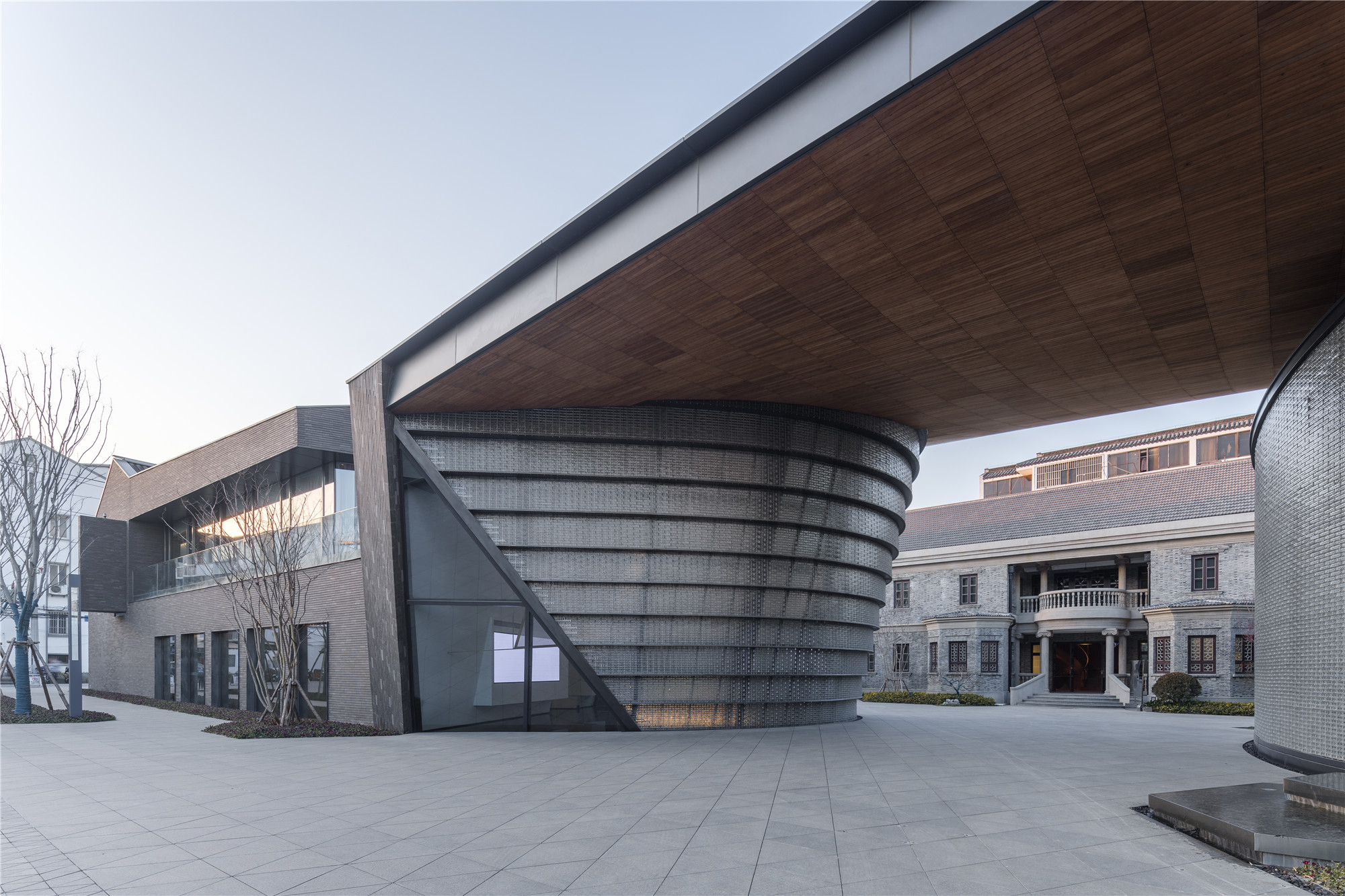
设计单位 上海日清建筑设计有限公司
项目地点 江苏苏州
建成时间 2020年7月
建筑面积 2866.71平方米
环境:时代旧痕
Environment: vestige of time
苏州古城仓街东侧,与苏州历史文化名街平江路仅相隔一个街区,这里是曾经有着“民国三大监狱”之称的苏州狮子口监狱。1937年国民党起诉“七君子”,当时宋庆龄、何香凝、胡愈之发起“救国入狱”运动。此外,陈公博、褚民谊、缪斌等在这里被执行枪决,汪精卫之妻陈璧君也曾被关押于此。
East of Cangjie, Suzhou stands “Shizikou (Lion Mouth)” prison that used to be one of the three major prisons during the Republic of China, and it is only one block away from Pingjiang Road, a famous historical and cultural street. The KMT brought a charge against the “Seven Gentlemen” in 1937, for which Soong Ching-ling, He Xiangning and Hu Yuzhi launched the campaign of “save the country and go to prison”. In addition, Chen Gongbo, Chu Minyi, Miao Bin and other prisoners were executed by firing squad here, and Chen Bijun, the wife of Wang Jingwei, was also jailed here.


如今,基地内仅保留了当时的一幢民国办公楼及一段围墙遗址。随着时间的侵蚀,后刷的涂料逐渐脱落,露出民国时期青砖墙面。从这栋普通的二层双坡屋面建筑上,当时西方文化对中国建筑的影响清晰可见。基地东侧与北侧旧时的聚落只剩下断壁残垣,未来这里即将被新式的江南街巷取而代之。
Now there only remain an office building of the Republic of China and a section of the prison wall. New paint gradually peels over the years, leaving the grey-brick wall of the Republic of China exposed. The influence of western culture on Chinese architecture can be obviously found in this two-storey double-pitched building. Former settlements east and north of the site are reduced to the dilapidated wall, and a new Jiangnan-style street will be built here.


初衷:记忆延续
Original purpose: making memories last
场所是不同环境下空间意义的呈现,而这份意义的产生要依附于人对于空间场所的集体记忆。对于苏州古城居民来说,街巷、院落所形成的开放包络空间是古城居民的共有记忆,是对于家乡场所的空间印象。
A place is the presentation of spatial significance in different environments, but such significance is created primarily depending on people’s collective memory of space or place. For residents in Suzhou, open and inclusive spaces formed by streets and courtyards are their common memory as well as a spatial image of their hometown.

基地范围之内有多处当地几代居民共同的记忆,办公楼、围墙、昭示着场地原有的场所氛围。站在历史与公众的视角上,设计意图有机地存留它们并使后代从中受益,在不破坏原有建筑历史价值的基础上激发场地潜能,在传承场所精神的同时赋予场所新的意义。
There are a few places with collective memory for local residents of several generations within the site. The office building and wall show the original ambience of the site. From a historical and public perspective, designers intend to preserve them for the benefit of later generations, stimulate the potential of the site without ruining historic value of the original building, inherit the spirit of the site and redefine it.

空间:新旧对话
Space: a dialogue between the new and old
基地内与旧房相伴的有一株百年古柏,它是过去一个多世纪历史的见证者。以此“空间日晷”为灵感,建筑师形成了最初总体布局的构思:以古柏为轴,形成一个连续的空间,对外与周遭的环境充分对话,对内形成向心型的内院,并向南侧的城市广场及地铁出入口打开,形成一个“窗口”,促使当代城市生活与历史建筑进行对话。
There is a century-old cypress nearby the old building, and it has witnessed the history of over 100 years. Inspired by the “sundial in space”, architects develop an initial idea of overall layout: with the old cypress as the axis, it forms a continuous space that establishes an effective dialogue with surrounding environment, makes up a centripetal inner yard and opens a “window” to the city square on the south side and subway entrance/exit. It facilitates a dialogue between modern urban life and historical building.
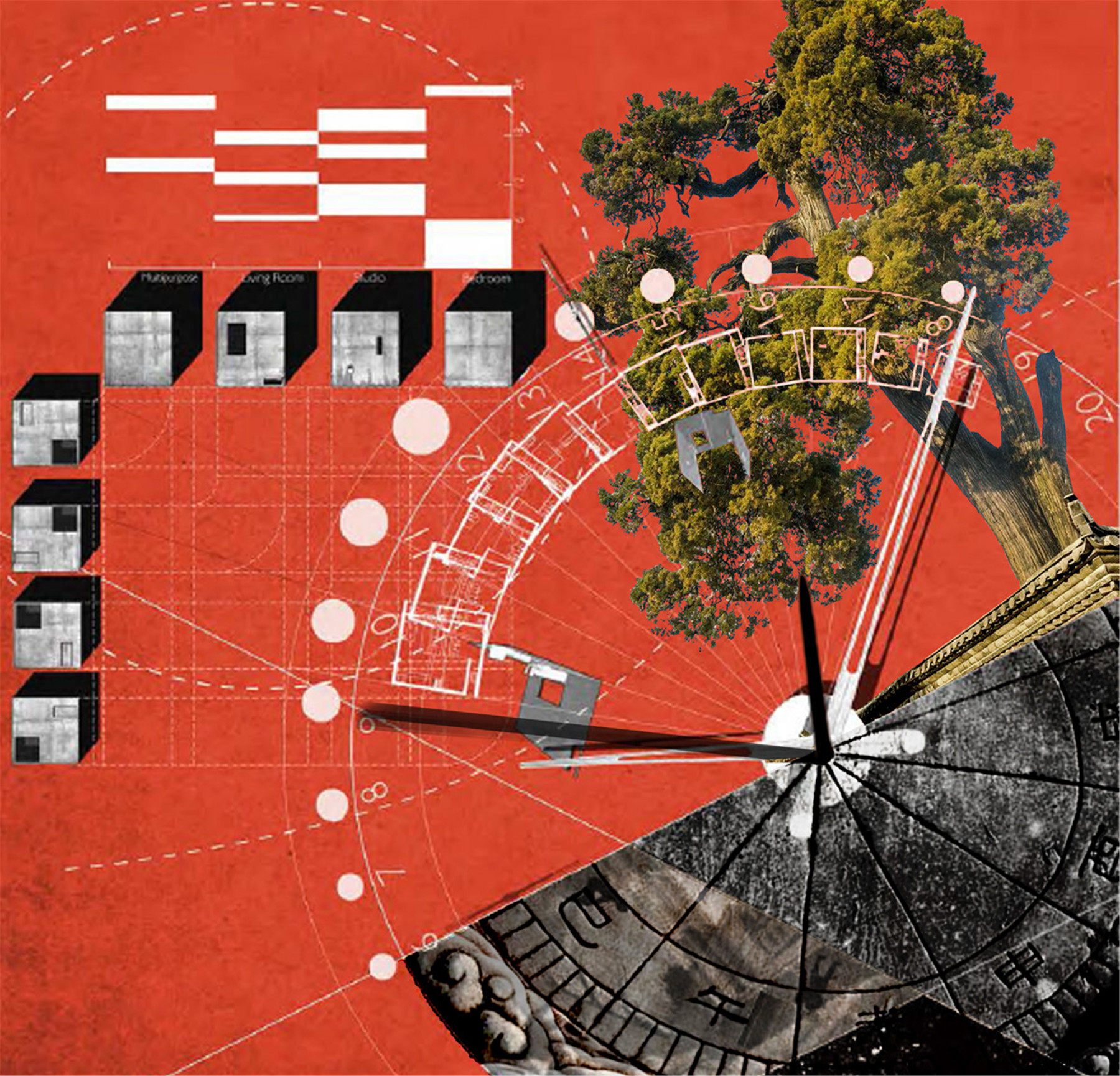


扩建展示馆作为时空上的一枚纽带,将办公楼、古柏与外部空间串联起来,是办公楼在时间维度的延展与生长。在扩建展示馆体量中,随处可见原有的建筑特征,但又各自保留恰当的独立性,新与旧的视觉冲击感被淡化,进而生发出新的整体。新老建筑在同一时空上叠加、并置,相互为邻。
The exhibition hall extension serves to link office building, old cypress and external space. It is temporal extension and growth of office building, as original architectural features can easily be seen in the extension, yet they retain proper independence. The new-old visual impact is weakened so that a new entirety emerges. New and old buildings are superimposed and juxtaposed in the same time and space.



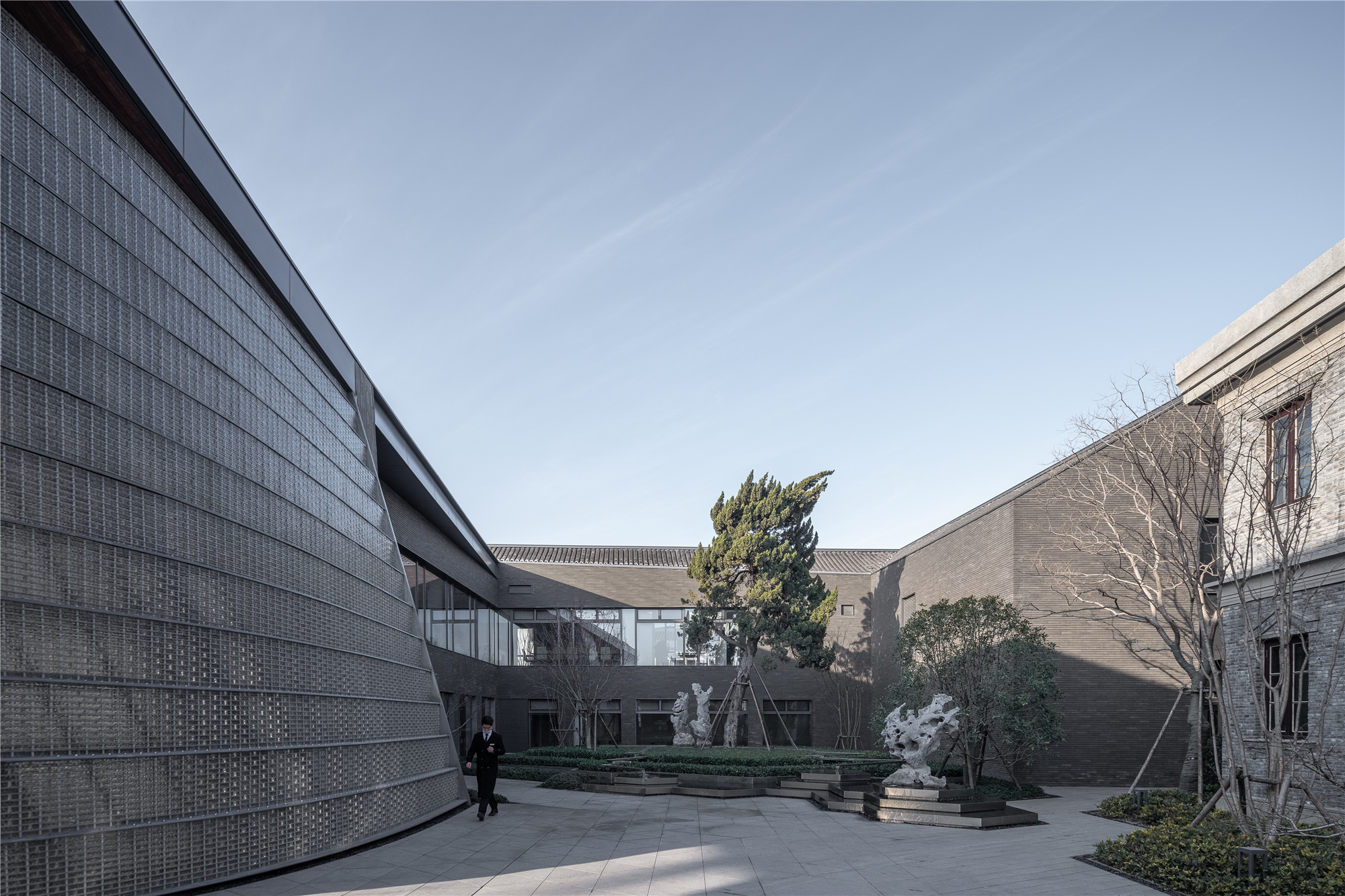

形式:同句多义
Form: sameness in diversity
新建筑的屋顶以办公楼脊线的方向开始生长,依附于原有的双坡屋顶,进行如书画笔触般的勾勒,经过分裂旋转合并之后到达入口,建筑形体亦随之变化。通过渐消面将脊线消解,最终民国风格双坡屋面转变为苏式的单坡曲面,新建筑也成为民国风格建筑向传统苏式建筑过渡的桥梁。
The roof of new building begins to grow in the direction of the office building’s ridge line. Based on the original double-pitched roof, it splits, rotates and merges like brushstrokes, and then it reaches the southern entry with a different shape. As the ridge line is eliminated through the fading surface, the double-pitched roof of the Republic of China is finally transformed into Suzhou-style single-pitched surface. The new building also becomes a transition from the style of the Republic of China to traditional Suzhou-style.





在对于屋顶的操作之中,为了探求不同屋顶形态对于空间形式的影响,设计师通过参数化控制,将屋脊线控制为影响屋顶形态的唯一输入要素。脊线旋转角度调整过程中,可以随时观察到屋顶形态的变化及其与办公楼屋顶之间的关系。在这个过程中,可以直观地发现概念思路与落地应用之间的矛盾,并找寻到两者之间最佳的契合点。
We make the roof’s ridge line the sole input element affecting roof forms by parametric control; when rotation angle of the ridge line is adjusted, we can observe roof form change and its relationship with office building’s roof any time. In this process, we can easily find the conflict between concepts and applications and work out the best balance for them.


项目占据苏州仁恒仓街商业广场一角,其变化的转角设计,在视线转换的过程中让人们能够感受到空间扭转的力量,提供特别的街角呈现。屋顶上形态的拓扑变换将民国遗址双坡屋顶转译到弧线屋顶,在融合了不同时代建筑风格的同时又提供了特别的第五立面。
The project is situated at one corner of Suzhou Yanlord Cangjie Commercial Plaza, and its changing corner design allows people to feel the power of space twisting when the line of sight shifts. The topological change in roof form translates the double-pitched roof of the Republic of China into a curved roof, which combines architectural styles of different ages and also offers a special fifth façade.


从屋顶到建筑墙面,设计一直在尝试抽象城市片段的典型印象,并以不同的材质和形体传达具有遗传性的形式与空间。新建筑立面抽取办公楼立面形态原型,通过类型学的归纳并转译至扩建建筑之上,形成同一句式下的不同时代语汇的表达。
From roof to wall, designers always try to make the typical image of the city abstract and convey hereditary form and space through different materials and forms. The new building façade “borrows” the office building’s original façade form, and it is applied to the extension by typological method. It is lexical expression in the same sentence in different eras.
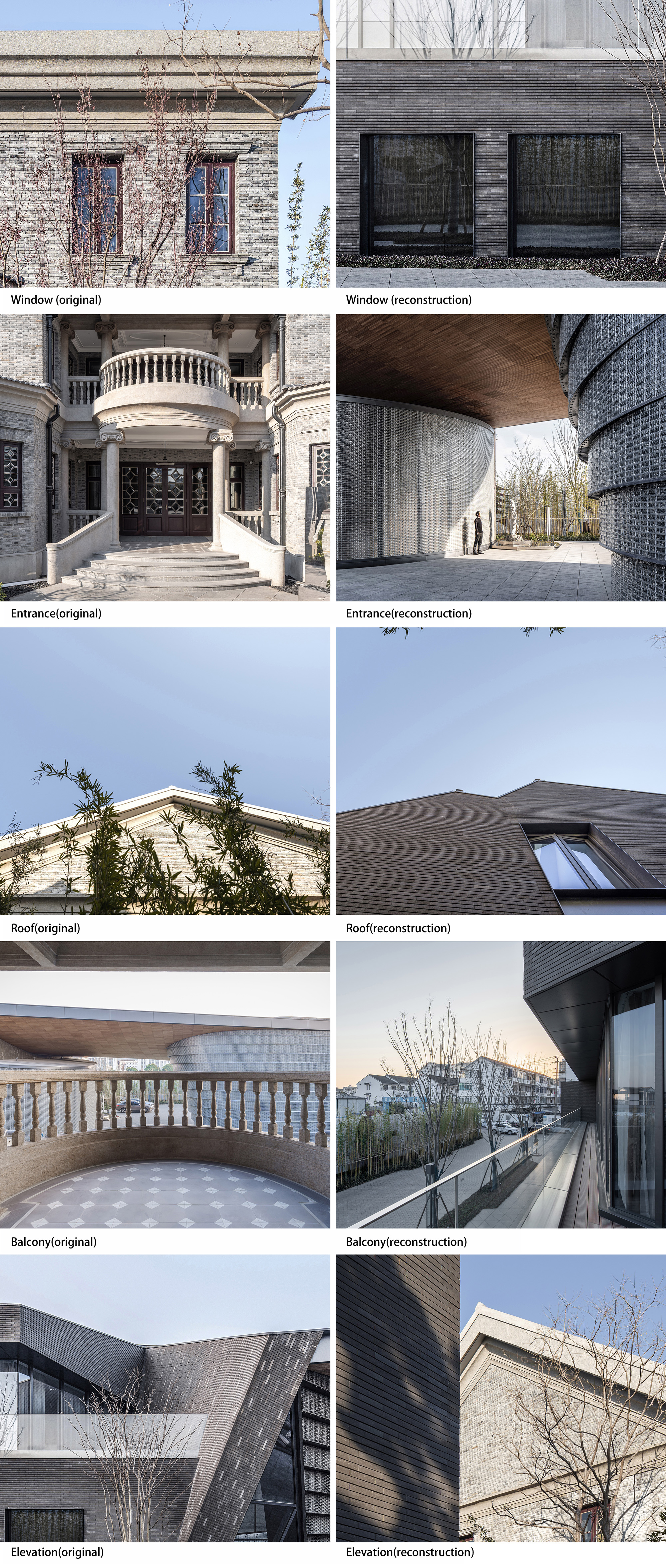
材料:异质同构
Materials: same structure with different textures
本案在修缮旧建筑时沿用了青砖,修旧如旧;扩建部分立面采用陶砖,沿用办公楼立面青砖肌理的同时创造一种新的触觉感知,在唤醒人们潜在记忆的同时,展现出新的场所印象。砖瓦肌理从屋顶一直倾泻至地面,空间素雅宁静。
Grey bricks are used for old building revocation in this project; ceramic bricks are applied to the façade of the extension, which is consistent with grey-brick texture of the office building’s facade and brings a new tactile sense. It presents a new image of the site and arouses people’s dormant memories at the same time. Brick and tile texture starts from the roof to the ground, creating an elegant and tranquil space.

入口处的圆弧形玻璃砖体量将内部办公楼与外部广场的空间关系朦胧化。对内折射故居投影,追忆历史;对外反射现代生活,展望未来。从青砖到陶砖,再到玻璃砖,新扩建建筑实现了旧建筑肌理的延续与质感上的迭代。
The circular-arc glass bricks at the entrance obscure the spatial relationship between the office building (inside) and square (outside), which serves to recall the history, reflect modern life and expect the future. From grey brick to ceramic brick to glass brick, the extension has achieved an inheritance and continuity in the old building’s texture.


结构:皮骨贴合
Structure: skin-skeleton combination
概念的诠释有赖于作为建筑“骨”的结构与作为“皮”的幕墙之间的完美贴合,具体操作中,为了应对扩建建筑变化的屋顶形态,设计采用了混合结构。
The interpretation of the concept relies on perfect combination of the “structure” (skeleton) and “curtain wall” (skin). To match new roof form of the extension, designers adopt mixed structure.

扩建展示馆主体采用钢筋混凝土结构,入口部分采用钢桁架结构,通过钢桁架充分拟合屋面造型,来满足最大跨度达21米同时完成面高度仅有700毫米的屋面系统。
The main part of the extended exhibition hall adopts reinforced concrete structure along with the use of steel truss structure for the entry. The steel truss well fits the roof shape to attain the roof system with maximum span of 21m and height at 700mm.


倾斜的玻璃砖墙暗示了斜向内院存在的同时,还隐含了对于新旧时空的转换。为了在标准化做法下实现设计构思,设计师首先优化了弧形曲面,将三维曲面转变为单曲面。之后在7.8米的高度中,每12排玻璃砖设一道钢板,与其背后的桁架竖挺一同控制出玻璃砖墙的退台趋势,同时为每一排玻璃砖的堆砌提供支撑。
The sloped glass brick wall suggests the existence of sloped inner yard as well as a shift of the new and old in time and space. To realize design ideas in a standardized way, we first optimize curved surface by changing three-dimensional curved surface into single one, then arrange steel plate in every 12 rows of glass bricks at the height of 7.8m, and finally control the setback of glass brick wall together with the truss and vertical frame behind the steel plate. Meanwhile, it provides support for the pileup of glass bricks in every row.


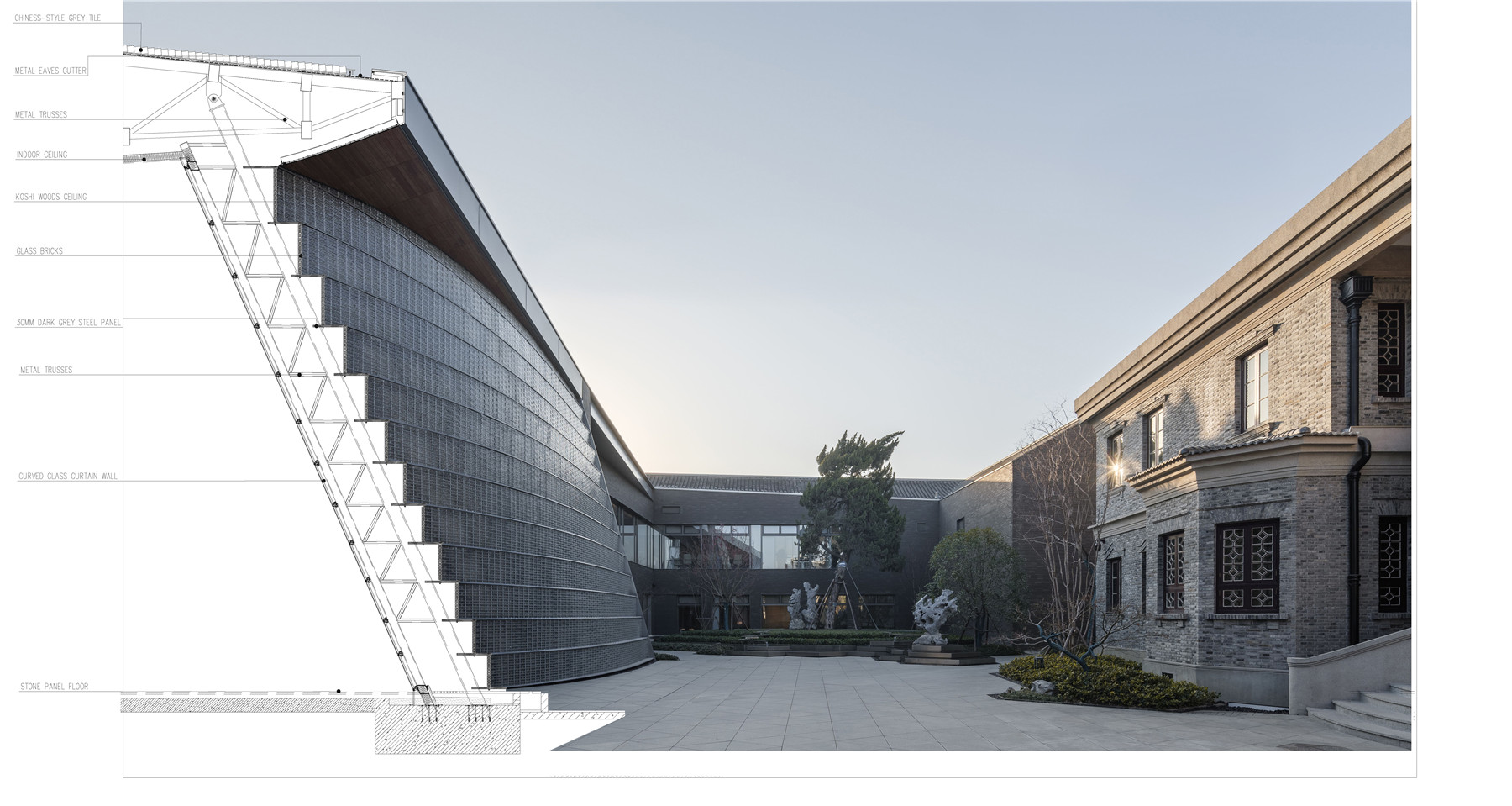
钢板与钢板之间拉结钢筋,将交错拼接的玻璃砖串在一起。为了实现免胶做法,设计师在玻璃砖墙内侧设置了一道弧形玻璃幕墙,保证了建筑的气密性和隔热性能的同时实现了立面的纯净整洁。
Steel tie bars are put between steel plates to connect glass bricks in interwoven arrangement. We set up an arc-shaped glass curtain wall inside glass brick wall to avoid gluing, which ensures air tightness and heat insulation of the building and also creates a pure and neat façade.
得益于最初对于曲面形态的优化,建筑结构与幕墙杆件最终完美地融合在一起,实现了“皮”、“骨”之间的高度贴合。
Thanks to the optimization of curved surface form, the building structure and curtain wall members are perfectly integrated, which is a perfect combination of the “skin” and “skeleton”.




功能:类型置换
Function: new type
历史的痕迹留在博物馆是静态的,留在生活中则是动态的。与百姓生活息息相关的活动不断地在这里发生,过去是这样,以后也还是这样。延续遗址生命的方式,应该是置入新的功能。
The trail of history is still in the museum, but dynamic in life. Activities related to people’s daily lives are happening here all the time, which is the same with the past and future. New functions are added to keep the site alive.


向民众开放之后的新场所办公楼旧址将改设为仓街历史文化展览馆,扩建部分则将展示新规划的成果。在仁恒仓街商业功能投入使用后,扩建部分则转变为特色餐厅,与旧址展馆一起成为引人注目的打卡地,原有场所氛围则在新的功能内容下,将得到新的延续和传承。
The former site of new office building that is open to the public will be converted into Cangjie History & Culture Exhibition Hall, and results of new plan will be showcased at the extension. After Yanlord Cangjie is put into commercial operation, it becomes a specialty restaurant and an attractive destination together with the exhibition hall. The original ambience of the site is inherited with new functions.

设计图纸 ▽




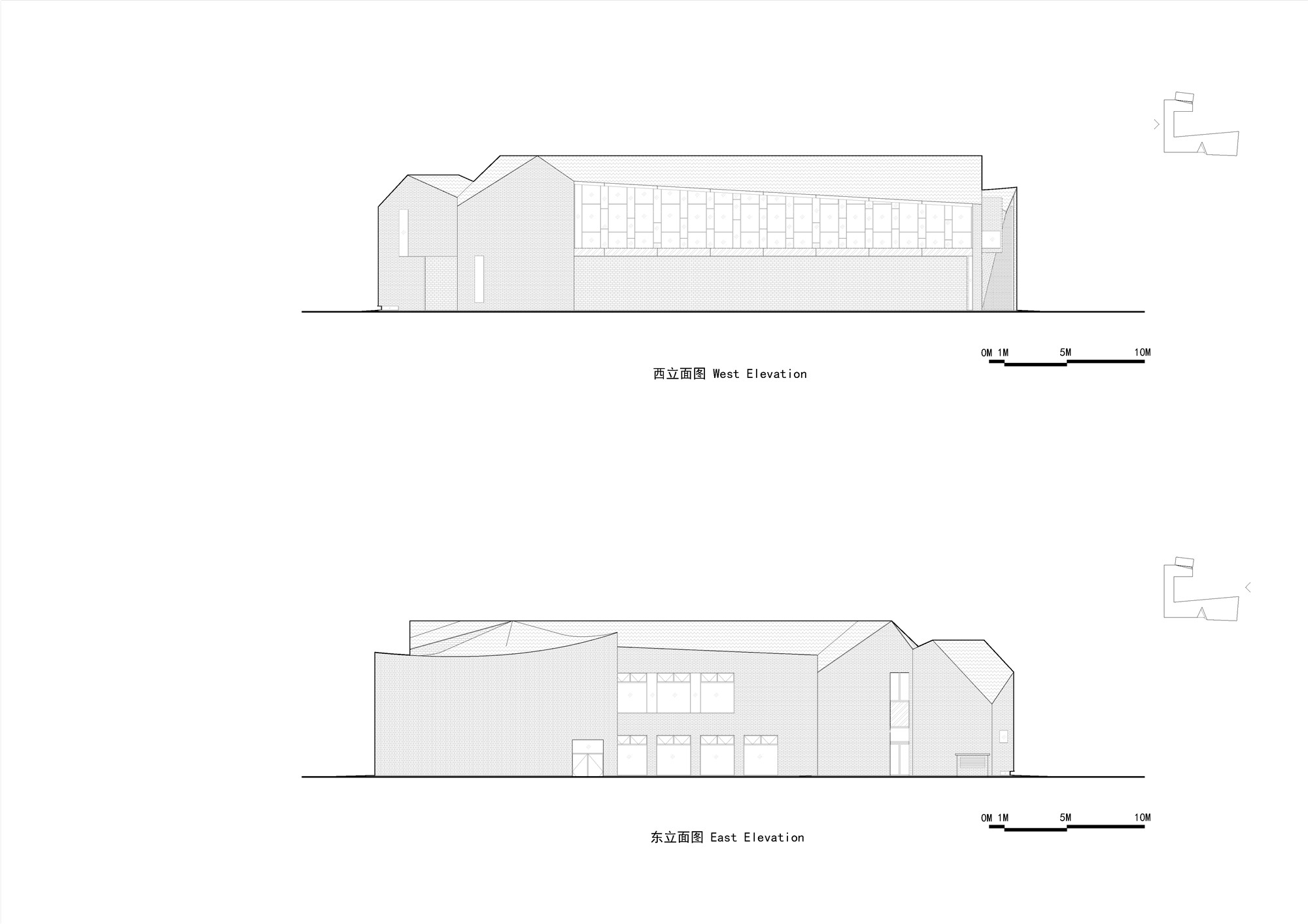

完整项目信息
项目名称:苏州“狮子口”遗址环境保护与扩建
项目位置:苏州市姑苏区干将路北侧 仓街东侧
业主单位:苏州星岛仁恒置业有限公司
设计单位:上海日清建筑设计有限公司
项目总负责:宋照青、岑岭
项目经理:初子圆
技术主管:郭丹
设计团队:赵晓雪、刘泽华、陈丹丹、吴旻琦、朱晓磊、王玉戈、于昕、高亚群
图表设计:陈诗韵、乔灵、温海宽
实景合成:徐睿鹏工作室
施工图设计:苏州城发建筑设计院有限公司
景观方案设计:诗加达景观设计公司
景观施工图设计:苏州致朗建筑景观设计有限公司
幕墙单位:上海熙玛工程顾问有限公司
室内设计:深圳市水平线室内设计有限公司
室内施工图设计:深圳市水平线室内设计有限公司
室内施工单位:南京仁生装饰工程有限公司
土建施工:中亿丰建设集团股份有限公司
幕墙施工:上海科胜幕墙有限公司
景观施工:浙江鑫胜园林绿化工程有限公司
建筑面积:2866.71平方米
建成时间:2020年7月
建筑摄影:CreatAR Images
版权声明:本文由上海日清建筑设计有限公司授权发布。欢迎转发,禁止以有方编辑版本转载。
投稿邮箱:media@archiposition.com
上一篇:公园化商业综合体:深圳欢乐港湾规划及东岸集群建筑设计 / Laguarda.Low Architects
下一篇:SDK熊本大厦:飘在立面上的“风帆” / 日建设计